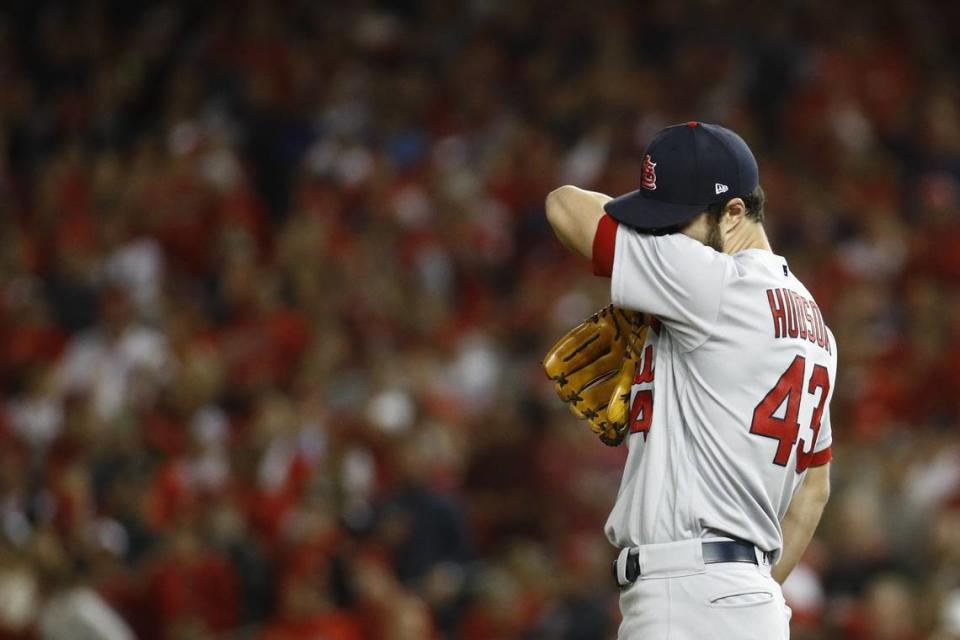Dakota Hudson loves being a Cardinal. But will he get a another chance with the big club?
- Oops!Something went wrong.Please try again later.
The only difference a fan might’ve noticed between Dakota Hudson’s body of starts in Major League Baseball and his outing Thursday night for the Triple-A Memphis Redbirds is that Thursday saw him capped close to 70 pitches.
That similarity carries positives and negatives. In large part it means that Hudson is healthy; for the first time in three years, by his estimation, he feels like himself. It also means that, even as he works through a system-wide program designed to goose velocity and induce swing and miss, he’s still humming along in the low 90s and keeping the ball on the ground, in play.
“This is the best my stuff has been as far as coming back,” Hudson said in summing up his start against the Omaha Storm Chasers. “The other day was some of the most consistent execution I’ve had.”
Execution, for Hudson, even perhaps more than other pitchers, is essential. Building velocity and spin will help make him more versatile, but if he misses location, he gets hit. His ball breaks down and, frequently, toward bats, by design.
Despite the changes to the rules which are designed to promote more contact — a pitch clock, and in the minors, the automated balls and strikes system — teams want swing and miss. The Cardinals aren’t alone in that, but it leaves Hudson in an unenviable position.
“There’s a lot of guys here that have kind of been on the velocity train,” Hudson said of the Memphis staff. “It’s been a good kind of, like, clubhouse build.”
Hudson’s build was interrupted with a recurrence of a neck issue that put him on the injured list in the majors last summer. A minimum stint then allowed him to build enough strength to get back on the mound, but he said that he never recovered fully. The Cardinals, already down arms, needed him to pitch, and he was healthy enough to take the ball.
Doctors, he said, estimated a less than five percent chance of the issue recurring, but early this season, it did. The resulting nerve pain radiated down his left arm, altering his mechanics and leaving him unable to generate his typical power out of his pitching motion.

More on Hudson
As a result, he wasn’t able to finish his pitches properly. He was missing small, but missing with consequences.
“Mechanically, I had something that was bugging it,” he explained. “I was able to kind of get that out of my (trapezius) that was kind of, like, leaking. Once I figured that out, I was able to keep my range of motion in my neck and it’s been building the strength in the upper back so that my trap isn’t taking over. My arms can just move the right way.”
Entering spring training, the Cardinals had five starters on the depth chart who clearly figured to be ahead of Hudson. In service of organizational depth (and in acknowledgment of the way his repertoire plays in the big leagues), rather than seek out a way to work him into the bullpen, he was optioned to the minors as camp wound down.
From there, he turned in four nightmarish starts in April; hitters in Triple-A mashed him to the tune of a .392 batting average and .532 slugging percentage in those starts. Much of those struggles can be traced back to the ongoing physical issues and Hudson’s willingness to pitch through them. After a while, losing a baseline of what it meant to feel fully healthy left him adrift and undoubtedly hurt his standing among the team’s big league options.
‘Trying to get the best caliber of myself’
Because he was called up slightly after midway through the 2018 season, Hudson finds himself staring at another complication — delayed free agency. A player has to accrue a minimum of six seasons of Major League service before being eligible to be a free agent, and if Hudson doesn’t make it back to St. Louis by the middle of this month — and it’s difficult to see that path — his opportunity will be delayed a year.
For a pitcher who will turn 29 at the end of this season and be a minimum of three years removed from his last undeniable stretch of productivity, the road forward is uncertain. Hudson says he “love(s) being a Cardinal,” but it’s an open question whether, given his current standing among the team’s decision makers, he’ll have an opportunity to be one again in the big leagues.
“Trying to get to the best caliber of myself,” he answered when asked about his goals for the year. “I know I can pitch at the big league level. I’m just trying to execute pitches at this point, get back to what I know I can do, and then wait for an opportunity. Right now, I’m trying to pitch my way into the conversation.”

